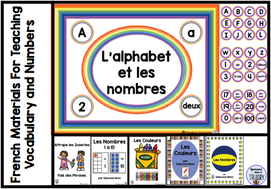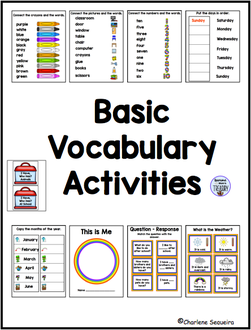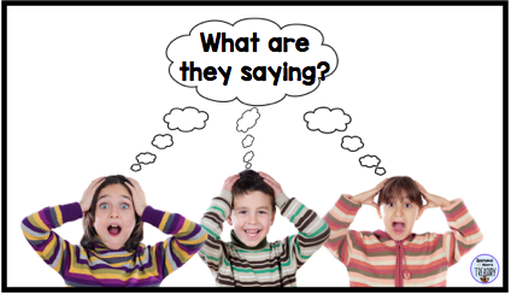|
Where does your inspiration come from when creating materials? For me it comes from a need for certain resources in the classroom or for my grandchildren to support them in their learning. I just started tutoring my grandson in French. He moved into a K/1 French Immersion class in March. He is in grade 1, but he is a capable student, so my son decided to move him early rather than do lots of tutoring over the summer and then move him into a grade 2 class. Already he is showing a good understanding of the language and he is able to figure out what is needed during the school day. He can read the words and he has a few phrases that he can use, but he is really starting all over again. As I began creating a few materials for him, I noticed how similar it was to creating materials for my guided reading groups of emergent readers. I decided to create a French version and an English version of each booklet or activity. So far I have created a few little readers and a package of interactive materials using basic vocabulary. I took my little English readers into the Learning Support Teacher and she was so excited. She said it was like Christmas! I am happy that she will be able to use them with her struggling readers. I also plan on using them with some of my emergent readers when I go in to volunteer with reading groups. When learning to read, it is the same process, no matter what language you are learning. I am looking forward to creating more resources that will be covering a variety of themes. Stayed tuned for the next group of books. Related Posts
19 Comments
Learning a second language doesn't have to be difficult. There are many ways to learn. Today I will be touching on a few strategies and steps that can help. There are 6 steps to follow if you want to really learn to use a second or third language. Not surprisingly, these are the same steps we use when learning our first language. They do not necessarily need to be done in this order or one at a time. Step one is to begin by listening to others speak so that you become accustomed to how the language sounds. This may seem a bit crazy, but if you go into any area where there are different languages being spoken, you will notice differences in the way the languages sound. I find it interesting to listen to people speaking to each other in a store or at the airport or some sightseeing venue. It doesn't take too long to recognize whether they are speaking in French, Spanish, Asian, or other languages. I may not be able to understand what they are saying, but some accents and sounds are distinguishable and characteristic of different regions or countries. Step two is to try speaking some of the words and phrases. This is usually done by copying what someone else is saying. It may be copying from a language program on the computer or at a listening center, or it may be copying someone who is speaking to you. With constant repetition, this will become easier and more natural sounding. Step three is to work on the pronunciation so that it is as close as possible to the native sound of the language. This will take practice. Recording oneself when speaking and playing it back may be helpful. Using a "telephone" is also a good way to hear what is being said. Step four is to develop a good vocabulary. The bigger the vocabulary acquired, the more a person will be able to communicate with others on a variety of topics. Step five is to practice reading the words and reading simple passages that use the vocabulary in written form. As fluency and comprehension develops the passages can get more difficult and varied. It is important that comprehension be included, because it is possible to read words fluently without understanding what is being said. This is particularly true for some languages that are very phonetic. Step six is to practice writing the language. The most difficult part of this process will be getting the grammar and syntax correct. Most languages are not translated literally, so you need to have an understanding of the language and how phrases are formed in order to communicate well. There are many different approaches, but these steps have worked well in our schools and with my own children and grandchildren. If you have other ideas or suggestions, I would love to hear about them in the comments below. Related Posts
Have you ever noticed that kids seem to learn languages more easily than adults? Children seem to be able to pick up the inflections and sounds more readily and they often mimic accents and dialects when they are around them for extended periods of time. This is not to say that adults cannot learn to be just as fluent as children, but sometimes it takes more effort to master it. When our children were young, we decided to put them in French Immersion. I live in Canada, and French is one of our official languages. We thought it would be good to have them learn a second language while they were young. Both my husband and I took French in school, and we managed to do quite well, but it was sometimes difficult to get the correct pronunciation for some words. The programs then were more focused on writing rather than on speaking. They were just beginning to use oral language for teaching. I continued to study oral French in university and then went on to teach in a French Immersion school. My husband studied other languages as well and he finds language acquisition easy. Many people opt to put their children into a language immersion program rather than have them study it as a course. Being immersed in a language, they tend to become familiar with the inflections, syntax, and basic grammar through hearing it being used on a continuous basis. When they are introduced to it in written form, it makes more sense. Of course, immersion is not for everyone and many people are able to learn well through classes also. (I found learning French fairly easy even though I didn't have the immersion setting.) Oral language acquisition is best done in a conversational setting. This allows for practicing phrases that are useful and practical with others rather than doing worksheets full of conjugating verbs, and learning lists of vocabulary words. Of course, in order to do written work and read passages or books in another language, some of these exercises are useful as well. It is important to find a balance that works. My next post will focus on 6 steps for learning a second language.  If you are interested in finding out more about French materials for language and numbers, check here. |
About Me Charlene Sequeira
I am a wife, mother of 4, grandmother of 9, and a retired primary and music teacher. I love working with kids and continue to volunteer at school and teach ukulele. Categories
All
|





























 RSS Feed
RSS Feed